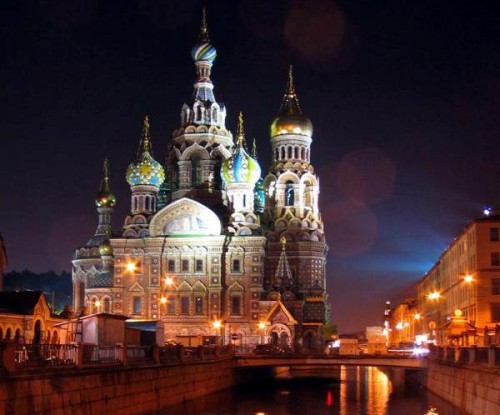 |
The Early
History of Russia
Written by
Rick Archer
January 2012
|
Rick
Archer's Note:
This is
the story of Russia's emergence as a world power. As
you will read, a fascinating feature of Russia's story is its
unusually late start onto the world scene. The dividing
point in Russian history is Peter the Great.
His effect on Russia was so profound that in a manner similar to how
we divide history based on the birth of Jesus, there is Russia
before Peter and Russia after Peter.
St.
Petersburg is one of the
world's most beautiful cities.
Founded in 1703 by Peter the Great, this city is the jewel in the
crown of Mother Russia. Home to exquisite art
masterpieces, magnificent museums, stunning palaces,
beautiful waterways, and breath-taking architecture, St.
Petersburg is a place that everyone who loves travel will
want to visit sometime in their lifetime.
|
|
Thanks to its
close association with Peter the Great, St. Petersburg is often considered
to be the symbol of Russia's emergence.
Before Peter
came along, this spot was deserted. This famous picture show
Peter scoping out a deserted marsh area where Russia's Neva River
emptied into the Gulf of Finland.
Peter decided this is was the place he would build his new city.
As Russia grew in importance, so did Peter's new hometown.
Petersburg now became the new gateway to Russia.
Moscow had been the seat of government for centuries. Over the
bitter objections of all the boyars, the nobles who ruled Russia,
Peter unilaterally decided to move the capital to his new city.
Disregarding the protests, Peter told everyone to pack their bags.
|
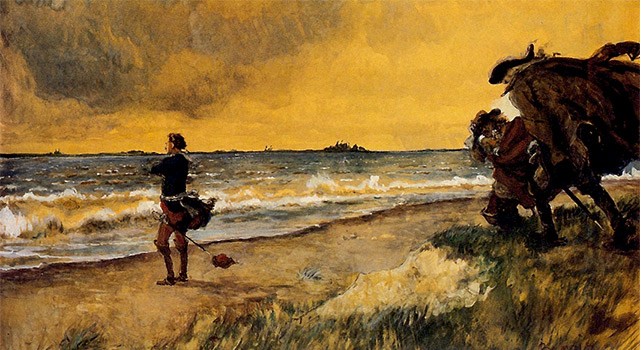 |
|
This move was
typical of Peter. Peter always got his way.
He dictated this new city was the way it was going to be.
You either followed his orders or you soon lost your head.
Literally. Peter was fond of beheading people who
didn't agree with him.
Sure enough,
the Muscovite boyars were soon buying real estate in the new
city. Petersburg became a monument
to both the good side of Peter and his
evil side as well. Petersburg was not only a shining
example of Peter's attempts to strengthen and modernize Russia,
it was also a symbol of his tyrannical rule.
After
Peter's death,
Moscow briefly regained its status as capital.
However 4 years later Empress Anna restored St. Petersburg as
the capital.
It took the 1917 Russian Revolution
to put a permanent
end to the Tsarist Era and Peter's Romanov line.
Moscow now resumed being the capital.
During the Marxist rule, Petersburg was renamed "Petrograd", then
"Leningrad" during the Soviet Era.
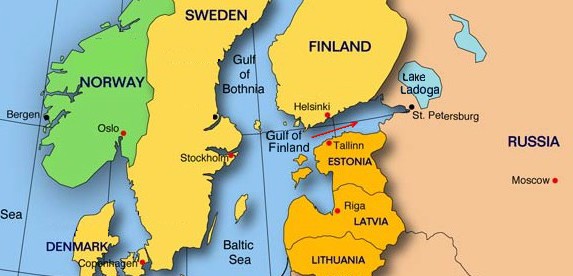 |
The 1991 collapse of the Soviet Union marked
the re-emergence of St. Petersburg's name as well as its importance
on the world stage.
Over the past twenty years, as Russia has gradually let down its
guard, St. Petersburg has become the most visited city in Russia by
a wide margin.
There are many reasons. As the map shows, St. Petersburg is
the only part of Western Russia easily accessible by water.
Second, thanks in large part to Peter himself, St. Petersburg has
always been the part of Russia that most identifies itself with
Europe. It is considered the most "Western" in its world
outlook. Third, the city is stunningly beautiful.
Fourth, St. Petersburg is where the early Russian Empire started.
Let's find out how it happened.
|
|
The
Early
Story
of Russia
From
its very beginning, Russia has suffered from a split
identity. East-West. European-Asian.
Christian-Moslem. Viking-Mongol. Even
its people look different.
The
people on the European side have
blond hair, blue eyes and fair skin. The
people on the Asian side
have black hair, brown eyes, dark skin and high
cheekbones.
The
land is so vast and populated by so many different
ethnicities that the concept of "national unity" has
always been very difficult to achieve.
As
opposed to being a "Cradle of Civilization", these
far-flung lands that would someday become the
largest country in the world were very slow to be
populated.
|
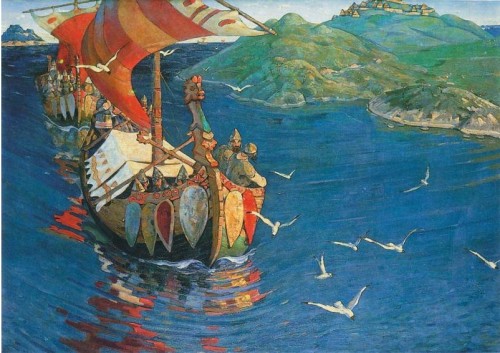 |
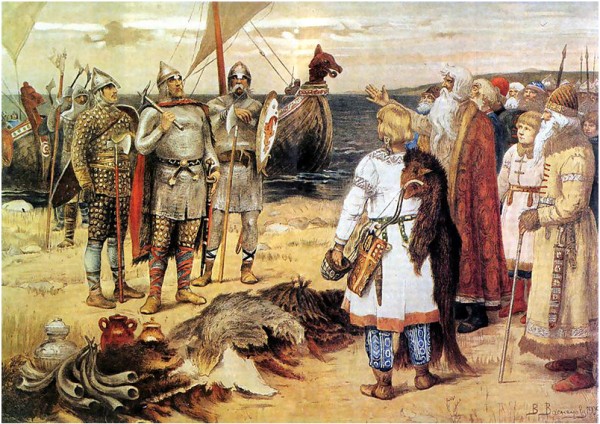 |
The
Varangians
Out of
all the different ethnicities that would populate
Russia, it was the Vikings who won the lottery.
The Vikings provided the root stock of
the group that came to be the eventual rulers of
this vast land.
The Varangians were Swedish Vikings who
sailed from Uppsala, Sweden, to begin exploration of
the lands in the eastern Baltic Sea in 862 AD. The
expedition was led by Rurik, a Varangian chieftain
Very
little is known about Rurik. The only
information about him is contained in the
12th-century Russian Primary Chronicle, which states
that the local tribes "…drove
the Varangians back beyond the sea, refused to pay
them tribute, and set out to govern themselves".
However, in a strange reversal of fortune, after
Rurik left, the tribes started fighting each other.
So they decided to invite Rurik back to reestablish
order.
|
If I am reading this correctly, it suggests
that after Rurik's departure, the natives suddenly
couldn't get along with each other.
Tired of their petty quarreling, someone suggested they
invite that nice Viking invader back to make
them all behave. What a fun idea!
This is not exactly
the most plausible story I have ever heard,
but that's what it says in Wikipedia.
Wikipedia isn't so sure about the story
either, calling it a "Legend".
Exactly. Like certain tales in
the Bible, I think I will take it with a grain of
salt. However, the one fact that
cannot be denied is that Rurik would go on
to become the Father Figure of Russia.
Now
that Rurik had been magically been welcomed back to
become the ruler, upon
his return he sailed across the Baltic, up the Gulf
of Finland and into northwest Russia using the
Neva River as his doorway to the continent.
He then sailed to Lake Ladoga
35 miles further inland from the mouth of the Neva
River.
As it turned out, the Neva River was the
only waterway in the entire Baltic Sea that
provided inland access to the amazing
network of Russian rivers. From this
point on, the Neva would provide the
pipeline to the Varangian occupation of
these new lands.
From Lake Ladoga, Rurik sailed south on the
Volkhov River. Rurik made Novgorod
his capital on
a spot on the Volkhov near Lake
Ilmen. Novgorod would
be the base that gave birth to the Rurik
Dynasty which would rule Russia until the 17th
century.
|
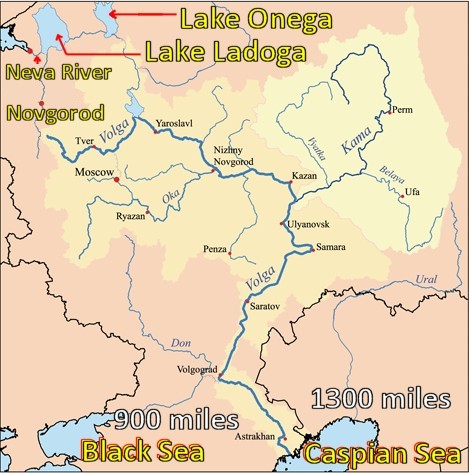 |
|
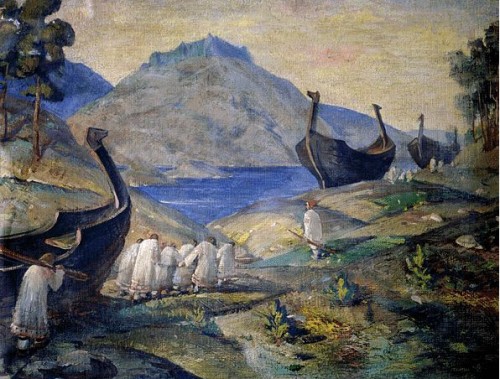 |
The
Varangian Riverboats
The Varangians
were absolute wizards at using rivers for exploration.
One river route discovered by the Varangians took them 900
miles from the Neva River to the Black Sea with only
two short portages. Another route shown in the map
above took the Vikings 1300 miles from the Neva River to the
Caspian Sea again with only two portages.
In their explorations, the Varangians used longboats
known as "Dragon Ships" that were perfect for navigating the
rivers of Russia.
The Varangians were very clever. As the
picture shows, they made their longboats light enough to be
carried in portage from one river to another. This
worked like a charm. As the Varangians would discover,
at certain points a portage of less than 30 miles would
allow them to reach new rivers that would carry them
hundreds of miles further.
|
The
Varangian Route
Most
of the early history of the Varangian occupation
took place primarily in the areas along the
Purple
Line
seen on the map.
This was a medieval trade route extending from
Scandinavia through Kievian Rus to Constantinople
and Greece. The trade route consisted of a
series of waterways and portages covering nearly 900
miles from the Baltic Sea to the Black Sea.
It began near present-day Stockholm and crossed the
Baltic Sea and the Gulf of Finland, followed the
Neva River, Lake Ladoga, the Volkhov River, Lake
Ilmen, and the Lovat River, and connected with the
Dnieper River by way of the Western Dvina River.
The route continued all the way along the Dnieper
directly to the Black Sea and then followed its
western coast to Constantinople.
|
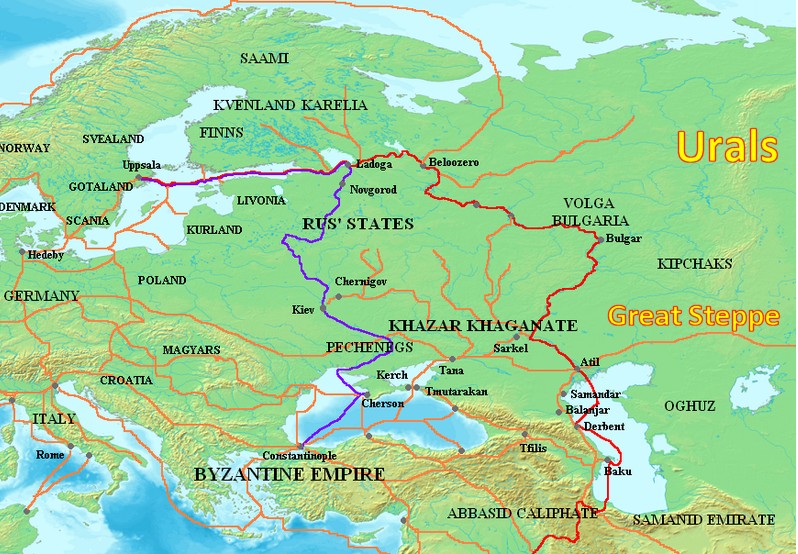 |
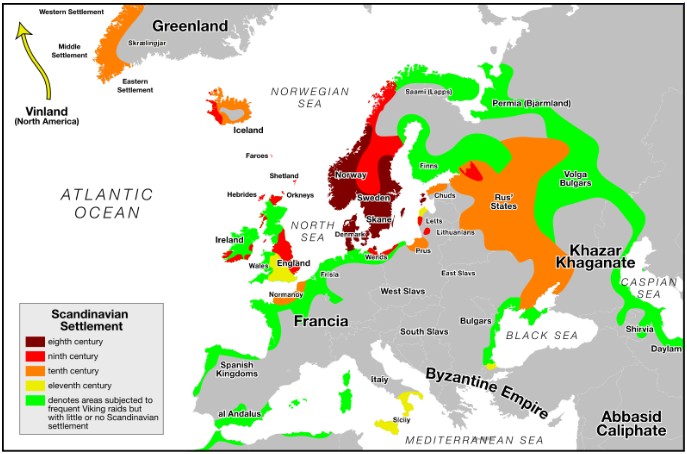 |
Russia is home to the longest rivers in Europe.
Indeed, the Volga, the
Ural, the Dnieper and the Don are
four of the five longest rivers in Europe.
Only the
Danube in second place breaks the Russian lock
on the top five spots.
Over
time, the Varangians established an impressive
system of waterways that allowed them to navigate
their way not just across Russia, but throughout
Europe as well.
Using
their amazing skill at navigation, the Varangians
established a very powerful colony all along the
trade route marked in
ORANGE
on the map titled "Rus States".
As it
turned out, the particular group of Varangians who
moved into this area were also known as the "Rus".
Like
the Spanish conquests in the Caribbean and the
British colonies in America, this area became
Sweden's "New World". The seeds of modern
Russia were sown.
|
| |
|
The
Ural
Mountains
The
Ural Mountains are Russia's answer to our own Rocky
Mountains. The Urals basically cut the
continent in half. One side is considered
Europe, the other Asia.
Although they are not nearly as tall as the Rockies
(6,000 feet versus 12,000), they played a major part
in the development of early Russia. Stretching
north and south for 2,500 miles, they served as a
strong deterrent for migration to the east.
The Varangians were more than content to completely
ignore the area to the east beyond the Urals because
there were no rivers to use for exploration.
As far as they were concerned, the Urals were the
edge of the Earth. For centuries the
Ural Mountains served as a massive barrier
to the expansion of the Rus people. As a
result, the early Russian civilization developed
totally in the west.
It
would not be till 1639 AD - 800 years after the
Varangians first settled in Russia - that the Kingdom of Muscovy would
finally make it to the Pacific Ocean. By
comparison, the Americans made it to the Pacific
within 200 hundred years thanks to the Lewis and
Clark expedition of 1804. And why the
incredible delay? Some guy named Genghis
Khan.
|
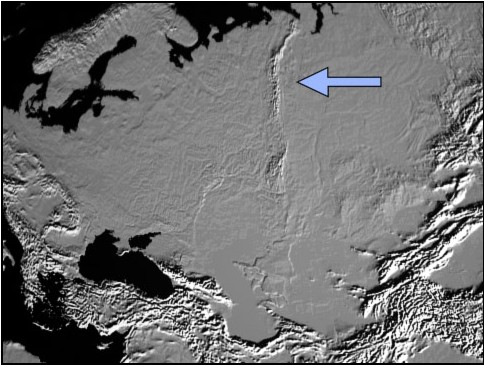 |
|
|
|
|
The
Great Steppe
The Great Steppe
was a vast open area stretching from Hungary to
Mongolia. There was no river route connecting
the East to the West, but the Great Steppe was the
next best thing. Passing just south of the Ural Mountains,
the Great Steppe
was practically an overland freeway. The Great Steppe would prove to be
just as important in the formation of Russia as the
rivers.
The Great Steppe corresponds roughly
to America's Great Plains. The
Great Steppe was an invitation to mass migration.
It became home to the majority of the early
population in the "non-Varangian" parts of Russia.
Over the centuries, conquering hordes and Eurasian nomads would
cross these vast grasslands, realize the farming potential and
stick around to colonize.
Sadly,
the farmers were always the great chumps of early
civilization. Agrarian societies were
incredibly vulnerable to raiding nomads on horses.
The farmers would time and again lose their crops to
invading armies passing through. Horsemen
could raid a village and be gone with their loot
before a land army could be gathered. Nor
could infantry easily pursue the horsemen.
This
harsh reality favored the Varangians to the north.
While the farmers of the Ukrainian Steppe were
constantly subjected to raids, the Varangian
settlements to the north near Novgorod and Moscow
had the forests for protection.
Living in remote areas
made inaccessible by thick forests, they were rarely
attacked by nomads. The horses of the
nomads were not
much of an advantage in the forests. The
forests not only made a quick escape difficult, the
brutal cold
temperatures made attack in the winter out of the
question. In addition, the
forests made it easy for the Varangians to build defensive perimeters.
This
would play a major factor during the Mongol
Invasions. While the people of the Ukraine
were slaughtered right and left and their towns were leveled, the Mongols mysteriously left the towns in
the forested area known as "Muscovy" largely intact.
They did conquer Muscovy, but didn't damage it very
much.
The
Mongols were content to allow the Muscovites to act
as agents in tax collection, making them lords over
the Ukrainians. The balance of
power between the Muscovites and the Ukrainians
would never be the same again.
|
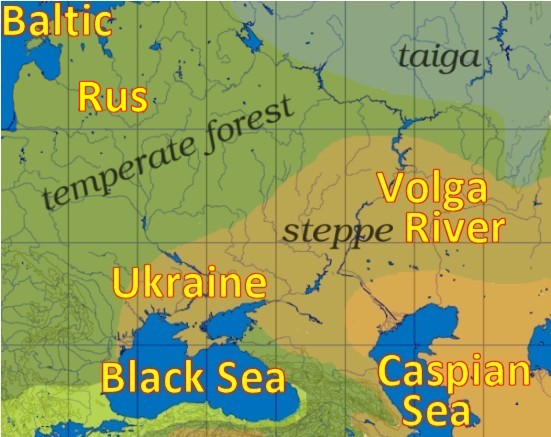
 |
|
|
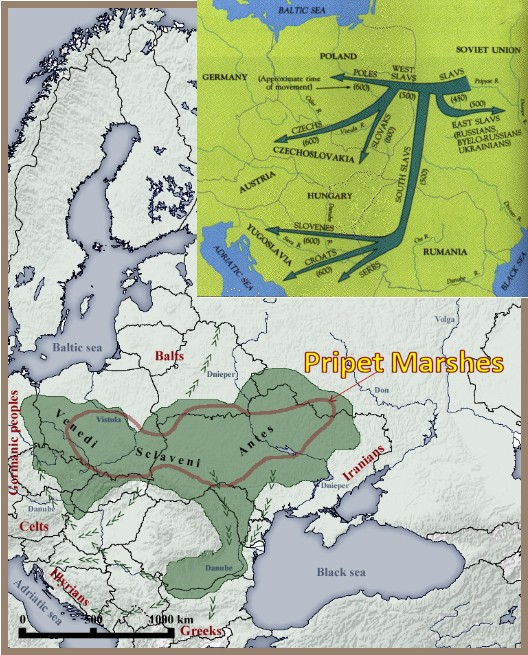 |
Origin
of the Slavs
In a
sense, the Slavs were to Russia what our own
American Indians were to the USA. The Slavs
were essentially the people who were already living
there when the Swedish Rus first began to explore
the inland via the waterways.
The Slavs were a major ethnic branch
of Indo-European people who lived mainly in central
and eastern Europe. The
earliest location of the Slavs has been identified
as the Pripet Marshes on the border
between northern Ukraine and southern Belarus.
It appears that the
Ukraine was the homeland of the Slavic people
as well as the epicenter of the massive Slavic migrations
that took place two hundred years before the Varangians
first came to visit their
territory in 862 AD.
Starting in the early 6th century, the Slavs spread
west to inhabit most of the Central and Eastern Europe
and the Balkans. Many others settled to
the east in
Siberia and Central Asia using the Great Steppe.
As the
early Slavs were agriculturalists, their migration
at this stage was not one of violent conquest by
warriors, but one of peaceful colonization by peasants
moving about with tents in family groups.
It is
interesting to note that while aggressive people
like the Romans, the Mongols, the Spanish, the
English, and the Vikings may have conquered vast
areas, the peaceful Slavs ended up with the highest
ethnic
percentage of the population of Europe.
This serves an interesting example of the meek
inheriting the earth.
The
Slavs were so prolific in colonizing new areas that
today over half of Europe's territory is inhabited
by Slavic-speaking communities. Blessed
are the meek...
|
The Slavs are
usually broken down into three groups.
Present-day Slavic people are classified into
East Slavic which includes Russians, Ukrainians,
and Belarusians. This is the largest group of
people of Slavic descent.
West Slavic including Poles, Czechs and Slovaks.
South Slavic includes Bulgarians and
people from Balkan countries such as Macedonians,
Slovenes, Croats, Bosniaks, Serbs and Montenegrins.
|
The Ukraine
The Ukraine was located just to the north
of the Black Sea at the western end of the Great Steppe. The Ukraine area was the perfect
breadbasket. Thanks to the good fortune of finding such
fertile land and great rivers, the native people known as the Slavs
had wonderful farmland to cultivate.
The fair climate and fertile soil compared
favorably with our Midwestern states here in America. For that
matter, the Ukraine is parallel to France, another country blessed
with warm winds and good agriculture. Proximity to the
Black Sea plus the Dnieper and
Don Rivers made it easy to transport goods back and forth
through the area.
The Varangians met the Slavs during their river
ventures into this territory. The Slavs were not much when it
came to war. At the time, they were paying tribute to the
Khazars, the early predecessors of the Cossacks. The
Varangians, on the other hand, were very warlike. They made
short work of the Khazars and claimed the land.
Unlike the bitter fight put up by the Indians during the western
expansion of the settlers in the USA, the Slavs didn't resist much
at all. They seemed to prefer
the Varangians over the Khazars, their previous landlords.
Soon enough the Varangians, also known as the Rus, were
installed as the new leaders. This took place in 880 AD.
The Rus and the Slavs quickly became assimilated and the capital was
moved from Novgorod to Kiev.
The united people came to be known as the Kievan
Rus.
For a time, the area was called the "Land of the Rus". As the
territory of the country expanded over time, it would eventually come to
be known as "Rus-sia".
|
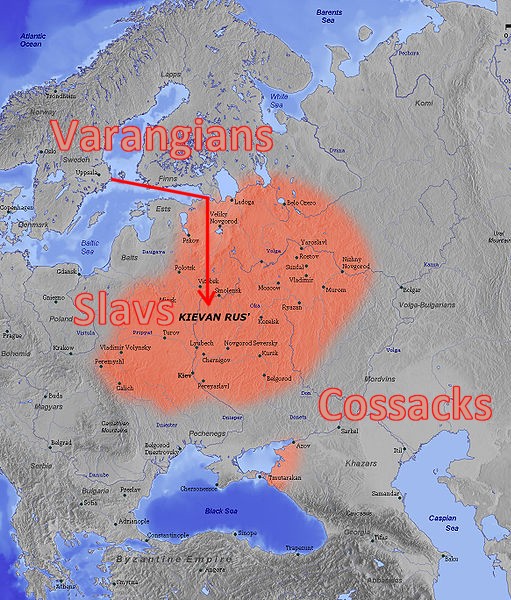 |
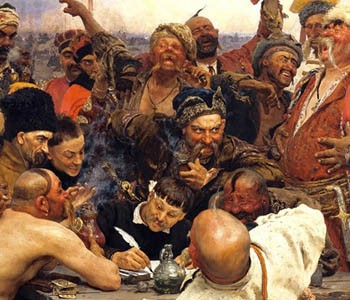 |
The
Cossacks
The word
"Cossack" is derived from the Turkic term kazak
that means "free man" or "adventurer".
The Cossacks were something of a mystery people.
They appeared seemingly out of nowhere in the 1400s.
The
Cossacks occupied the
area just to the east of the Ukraine.
This was pretty much
the same place where the Khazars, one-time
rulers of the Ukrainian Slavs, had lived.
One thing that is curious about this group
is that the Cossacks settled in these areas
AFTER
the Mongol Invasions of the 1200s, but at a
when the Mongol Empire still held the
Cossack lands within their power. So
where did they come from?
My guess is that these people didn't actually "come"
from anywhere, but rather had been living there all
along dating back to the days of the Khazars. In
fact, one reference suggested the Cossacks were the
direct descendents of the Khazars. During the
Mongol Invasions, the people of the region fled to
the hills and the forests. Then later as the power of the Khans began to fade, the
indigenous people began to regroup.
|
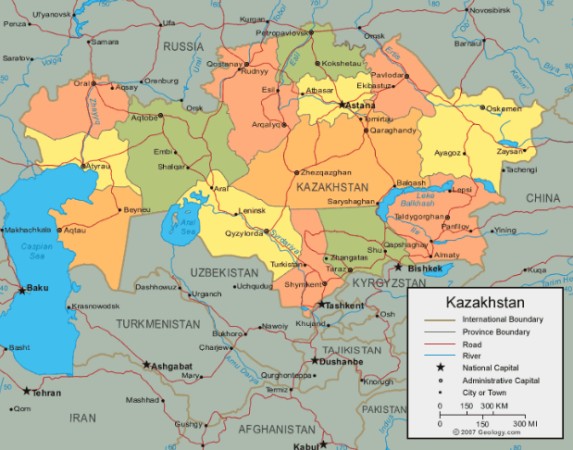 |
|
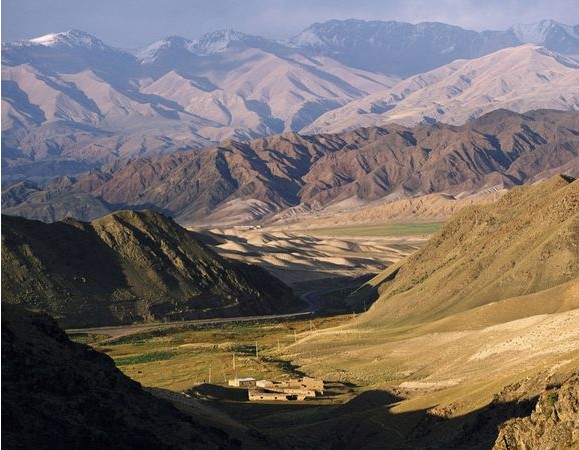 |
Occupying the lands southeast of
Ukraine and north of
the Caspian Sea, the Cossacks centered their civilization
around the Volga River and its many tributaries.
In addition, the Cossacks occupied the lands
directly between the Black Sea and the Caspian Sea. Later as the power of the Mongols faded, the
Cossacks expanded even further to the
east of the Caspian Sea. This area would
someday become the modern Kazakhstan (see
map)
If you pronounce this name correctly, it sounds
exactly like "Cossack-a-stan".
Since
the Cossacks occupied such a far-flung area, I think
it is safe to assume that the Cossacks were simply
the descendents of all the people living along the
Great Steppe that somehow managed to survive the
Mongol Invasions.
The
Cossacks were excellent fighters and master horsemen. They
lived nomadic lifestyles similar to that of the gypsies
or the American Indians.
When they weren't fighting or riding their horses, you
would find them with playing the balalaika or sharpening
their swords.
The appearance
of the Cossacks coincided with a major infusion of refugee
peasants fleeing from Russia. Thanks to developments
over in Russia related to the Mongol Conquests, some pretty
nasty rules had been implemented that had turned the serfs
into virtual slaves. In earlier times there were few
restrictions placed on the movements of peasants. They
could work for anyone they liked.
However, during the Middle Ages, the land-holding members of
Russian society known as the Boyars found ways to bind the
peasants firmly to one piece of land.
|
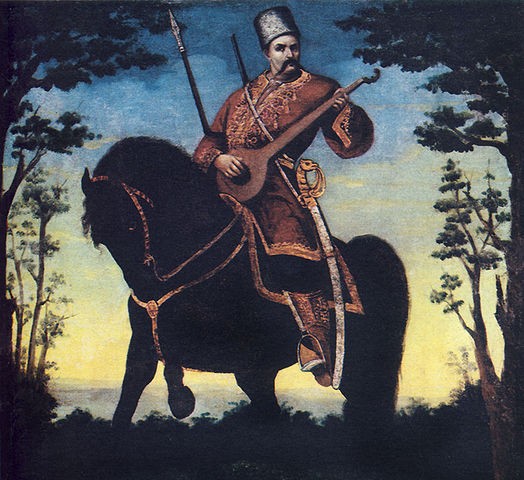 |
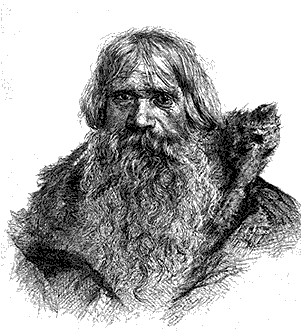 |
The Boyars
justified the system as the only way to guarantee a supply
of peasant labor. The Boyar landlords would loan the
peasants money. Then they would force the peasants to
keep working for the same landlord until the debt had been
paid. Unfortunately most peasants could never earn enough to
do that; most could barely meet the excessive interest rates
charged them. They were trapped and so they remained,
year after year, in a condition not much better than
bondage.
Whereas in
earlier ages the peasant was free to move where he liked
when all debts were paid, they were now required to work for
the same landlord for life, under threat of torture, exile,
or death. Furthermore, the institution of serfdom
became hereditary; sons could not leave the households of
their fathers.
This was the
beginning of 400 years of Russian feudalism. The
majority of the serfs were forced to live and die under the
yoke of the hated Boyars. It doesn't take much to see
this was where the bitterness that would lead to the Russian Revolution
first started.
|
Practically the only way people could find
any freedom was to escape and join the ranks
of the Cossacks who lived on the edge of the
Russian frontier.
The Cossack numbers increased as peasants
continued to desert the Muscovites in
droves. They fled to the southern
and eastern frontiers of the Russian
countryside. Along the Volga, Dnieper
and Don Rivers, these lawless frontiersmen
adopted the nomadic life of the barbarians
who lived there now. The refugees came to be
known as Cossacks as well.
The Cossacks were fiercely independent.
They lived by hunting, fishing, or raiding
somebody else; farming was forbidden.
Not only did farming symbolize the
oppressive life they had freed themselves
from, they also avoided farming because it
would make it easier for their enemies to
find them. Apparently they preferred
to live near
heavily forested areas that allowed them to
hide like Robin Hood from the Khan rulers
who dominated the area or the Muscovites who
came looking for the escaped serfs.
Once they reappeared, it didn't take long
for the Cossacks to become a force to be
reckoned with. The Cossacks were
completely independent of Russians to the north and west. Anytime the
Russians attempted to dominate them, they resisted
fiercely.
The Muscovites switched tactics. They
learned that if they left the Cossacks
alone, they frequently allied
themselves with the Russians when faced by common
threats. The
Cossack-Russian relationship could best be described
by the expression "the enemy of my enemy is my
friend".
|
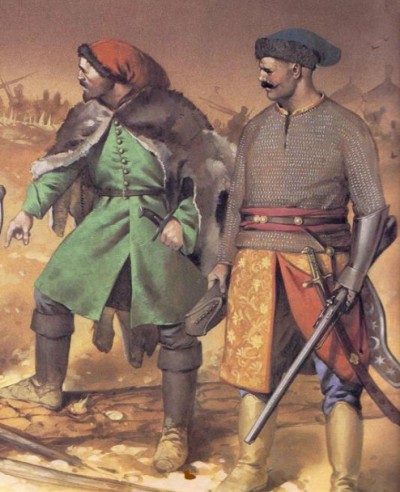 |
Since
the Cossacks hated the Poles, Lithuanians, Mongols,
Tatars and Turks as much as any other Russian did,
they would help the tsar in his foreign wars.
However, if the tsar or the boyars tried to get
their runaway peasants back, the Cossacks would
proudly boast, "There
is no extradition from the Don River."
After
being asked in 1539 by the Ottoman Sultan to
restrain the Cossacks, the Grand Duke Vasili III of
Russia replied: "The
Cossacks do not swear allegiance to me, and they
live as they themselves please."
In
1549, Tsar Ivan the Terrible replied to a request of
the Turkish Sultan to stop the attacks of the Don
Cossacks, stating, "The
Cossacks of the Don are not my subjects, and they go
to war or live in peace without my knowledge."
In
time, the Russians and the Cossacks developed a
detente. This was a smart move because the
Cossacks would prove invaluable to the
Muscovites on many occasions. Not only would they help
the Russians throw off the rule of the hated
Mongol Khans in the 1500s, they successfully
blocked the northern expansion of Turkey's Ottomon Empire past the Caspian Sea.
|
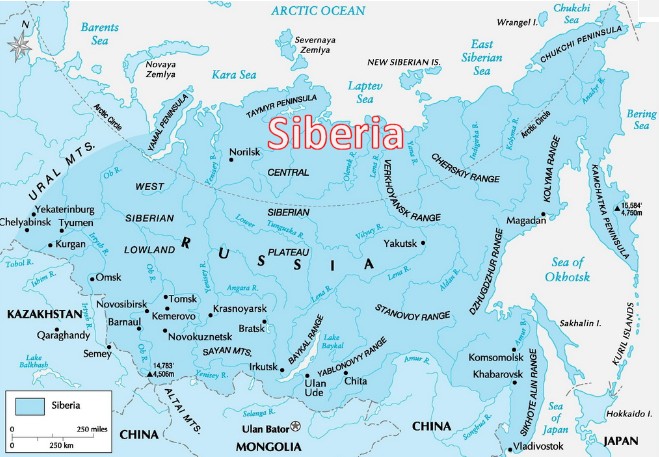
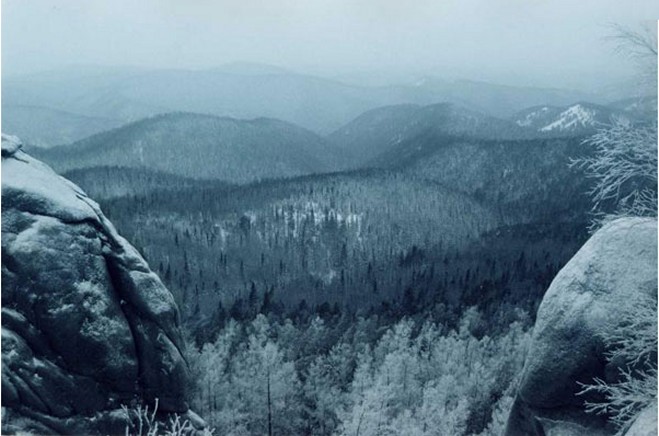 |
Siberia
Just saying the word "Siberia" makes most people shiver.
Siberia is legendary as the place where no one wants to
go.
If the Ural Mountains are considered the dividing point between
western and eastern Russia, then only one quarter of Russia actually
resides in Europe. The vast eastern part of Russia is
considered to be part of Asia. The term "Siberia" refers to
the entire region east of the Ural Mountains.
The individual territories of Siberia includes immense
Asian regions with names most Americans have probably never heard of
unless they played Risk as a child. According to Risk,
Siberia consists of obscure places such as the Urals, Irkutsk,
Yakutsk, and Kamchatka. It seems funny to realize
that most people's knowledge of Russian geography comes from a kid's war
game.
Siberia has always carried the reputation as "No Man's Land".
Historically, anyone who fell into disfavor with Russian authorities
was sent to prison in some godforsaken part
of
this barren, frozen tundra. Considering most were never seen
again, the threat of expulsion to Siberia was quite an incentive to be good!
Due
the extreme cold, Siberia is a very harsh place to live. That
said, there is life. Many people are not aware
that Siberia is home to a larger "rain forest" than the
Amazon jungle itself.
Life isn't easy in Siberia. There are problems with living
there that most of us can not even conceive of. I once wrote
a very interesting story about a major highway in Siberia that turns completely to mud whenever it rains in the summer.
This is everyone's worst nightmare because it strands motorists for
days in the middle of nowhere! Not only that, all commerce is
brought to a halt until the road dries. It is an enormous
problem. (Russian
Highway From Hell).
Today almost all the population lives in the southern parts of
Siberia along the route of the famous Trans-Siberian Railway.
Devoted fans of Doctor Zhivago may remember the brutal train
ride that took Yuri and Lara from Moscow to his countryside home in
the Ural Mountains. That train ride left an indelible
impression that Russia is the very definition of "endless".
|
|
|
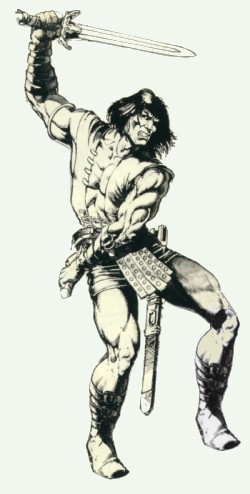 |
In the movie
Independence Day, the people of Earth awaken to see alien space craft
hovering in the sky. The threat is so ominous that the entire world trembles in fear. We
consider this story a far-fetched fantasy, but to the people of Asia and Europe, the
appearance of Genghis Khan and his barbarian armies on their doorstep was the
real thing. Mass murder and destruction on an unconceivable scale was
about to begin.
Genghis Khan
forged the initial Mongol Empire in Central Asia, starting with the unification
of the central Asian confederations such as Merkits, Tartars, Mongols, and
Uighurs. He then continued expansion of the Empire via invasion in what is
modern-day Uzbekistan. His name quickly became synonymous with the term "barbaric".
Large areas of Islamic Central Asia and northeastern Iran were seriously
depopulated. Any town that resisted the Mongols was subject to
destruction. Even the slightest resistance was punished by complete
annihilation. At Termez, a city on the Uzbekistan/ Afghanistan
border, "all the people,
both men and women, were driven out onto the plain, and divided in accordance
with their usual custom, then they were all slain".
Each soldier
was required to execute a certain number of persons, with the number varying
according to circumstances. For example, after the conquest of Urgench, each
Mongol warrior was required to execute 24 people.
|
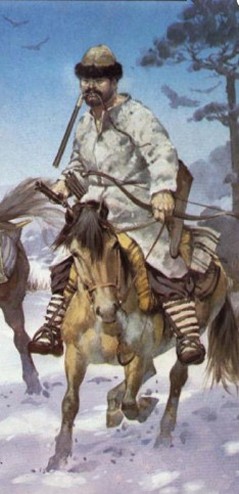 |
The
Mongols didn't stop with Asia. They kept
heading west, destroying everything they came in
contact with. In 1223 at the battle of Kalka, a river
in the Ukraine, the Russians were beaten badly.
After
that victory the Mongols forced the leaders of their
captives to lie down while they built a large wooden
platform over them. The Mongols then held a feast on
the platform, crushing the Russians to death.
They ate their meal without a problem as the men
below them screamed in agony.
After they had invaded and destroyed Kievan Rus, the
Golden Horde kept on going. Next up was
Poland, then Hungary and many others. Over the
course of three years (1237–1240), the Mongols
destroyed and annihilated almost all the major
cities of Eastern Europe.
Giovanni de Plano Carpini, the Pope's envoy to the
Mongol Great Khan, traveled through Kiev in February
1246. He wrote:
"The Mongols attacked Rus, where they made great
havoc, destroying cities and fortresses and
slaughtering men; and they laid siege to Kiev,
the capital of Rus; after they had besieged the
city for a long time, they took it and put the
inhabitants to death.
When we were journeying through that land we
came across countless skulls and bones of dead
men lying about on the ground. Kiev had been a
very large and thickly populated town, but now
it has been reduced almost to nothing, for there
are at the present time scarce two hundred
houses there and the inhabitants are kept in
complete slavery."
|
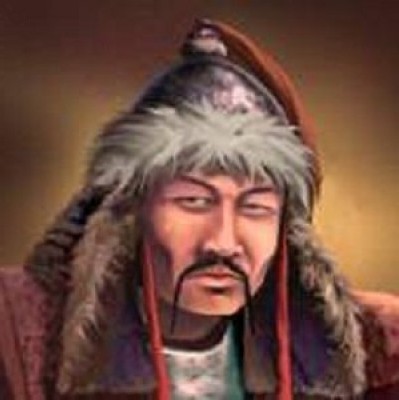 |
The
Mongol Empire
Until the
British Empire came along hundreds of years later, the Mongol Empire held the
record for the largest Empire of all time. The Golden Horde of
Genghis Khan and his successors would keep Russia subjugated for 250 years.
Since the
Mongol Empire was now too large to be effectively governed from one place, it
broke up into four smaller but still formidable states during the next
generation. Batu Khan and his heirs were awarded the northwest corner which
included the Ukraine, the valley of the Volga, and western Siberia.
They chose not to rule the Russians directly. In the forests of northern
and western Europe, their mounted archers of the steppes would find both their
speed and the range of their arrows reduced. This would put them at a
great disadvantage against the natives.
Instead, they gathered tribute.
|
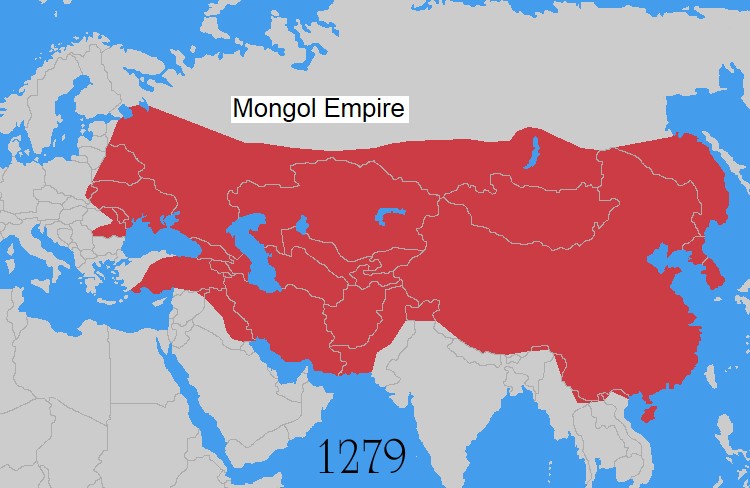 |
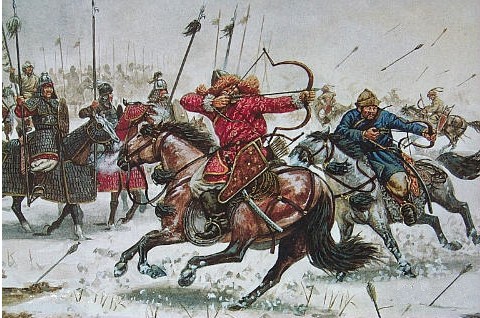 |
In a move that would have far-reaching consequences, the Khan would pick one Russian prince
per territory and give him a permit to claim the wealth
of Russia for the Khan. If the annual collection of gold and slaves
did not meet the Khan's demands, the Mongols would raid the
offenders to show they meant business.
The Russian Prince often grew to become as brutal and ruthless as
the Mongols he served. He resorted to violence without hesitation
while doing his collecting.
Under this system the Russians learned a lot about tyranny,
brutality, and inhumanity in general. These traits would
appear in the types of governments they would establish in the
future. This led to the system that turned the serfs into
slaves.
Before the arrival of the Mongols in 1240, the Russians were generally a friendly, trusting people;
unfortunately, in the opinion of some, those traits do not
characterize the Russians who have lived since then.
|
|
|
|
|
Dawn of the Russian Empire
|
The
Grand Duchy of Moscow
It
could be argued that the Mongol Invasion was the
most important event in the development of Russia
since the appearance of the Varangians. In a bizarre
turn of events, the 250 years of Mongol domination actually paved
the path which would allow this subjugated land to one
day become the mighty Russian Empire.
The
Grand Duchy of Moscow was a late medieval Rus'
principality centered on Moscow. Also known as
Muscovy, it was the predecessor state of the early
modern Tsardom of Russia.
The politics of the Mongol domination worked
greatly to the advantage of Moscow. Muscovy
was conquered just like all the other lands, but
managed to acquire a privileged status. While Kiev had been
flattened by the Mongol invasion, Moscow was not
badly harmed.
Moscow
rose to
prominence during the years of the Mongol-Tatar yoke by
using a questionable yet highly effective tactic known as
"sleeping with the enemy".
|
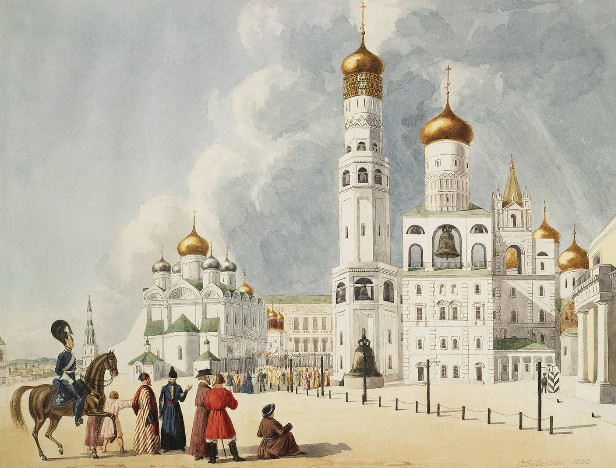 |
Moscow's eventual dominance of northern and eastern
Rus was attributable to its strange alliance with
the Mongols. In a move eerily similar with
France's Vichy Republic siding with the Nazis,
Moscow did exactly the same thing by collaborating
with the Mongols.
Back
in those days, Moscow was still just one of the
pack. There were several other cities in the
lands of Rus such as Novgorod, Vladimir, and Kazimov
that had just as many people and just as much
influence. However with the decline of Kiev,
another city, Tver, was the largest rival to
Moscow.
Tver
was located at a strategic position on the Volga.
Surrounded by woods and bogs, the Tver principality
was quickly transformed into one of the richest and
most populous Russian states after the Mongol
invasions due to its secure position. As the
area was hardly accessible for Tatar raids, there
was a great influx of population from the recently
devastated South. By the end of the century, Tver
was ready to vie with Moscow for supremacy in
Russia. Both Tver and Moscow were young cities, so
the outcome of their rivalry was far from being
certain.
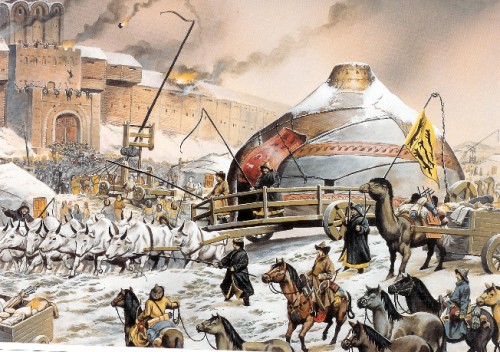 |
Mikhail of
Tver, who ascended the throne of Vladimir in 1305, was one
of the most beloved of medieval Russian rulers. His policy
of open conflict with the Golden Horde led to his
assassination there in 1318. His son Dmitry succeeded him
and created an alliance with the mighty Grand Duchy of
Lithuania that raised Tver's prestige even higher. In
1327, Dmitry, the Prince of Tver, joined a major
rebellion against the Mongols.
Over in
Moscow, Prince Ivan Kalita, soon to be known as Ivan I, was
exasperated by Dmitry's growing influence. He secretly
persuaded the Mongols to murder Dmitry. On hearing the
news of this assassination, Tver revolted against the Golden Horde.
Ivan I joined
his own forces with the Mongols in brutally crushing Tver.
He made sure the Mongols
devastated its lands. Many citizens were
killed, enslaved, or deported. This was the fatal blow to
Tver's pretensions for supremacy in Russia. They would
never be heard of again.
|
They
say the end justifies the means. In this case,
Ivan had sent thousands of fellow Russians to an
excruciating death to advance his own political
position. Whether Ivan Kalita was justified in his
actions was debatable, but there is no question that
Ivan had made a shrewd move.
Ivan had not only eliminated his main rival,
he was now able to move the headquarters of the Russian Orthodox Church to Moscow.
For his complicity, Ivan was
granted the title of Grand prince by the Mongols.
As
such, the Muscovite prince became the chief
intermediary between the Mongol overlords and the
Rus lands, which paid further dividends to Moscow's
rulers. While the Mongols often raided other areas
of Rus, they tended to respect the lands controlled
by their principal collaborator. This, in turn,
attracted nobles and their servants who sought to
settle in the relatively secure and peaceful Moscow
lands.
Emboldened by his status, in 1339 Ivan Kalita dared
to make Moscow even stronger by rebuilding a
powerful fortress around the city known as the
Kremlin.
|
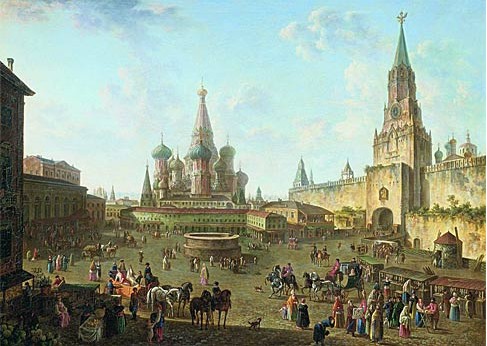 |
|
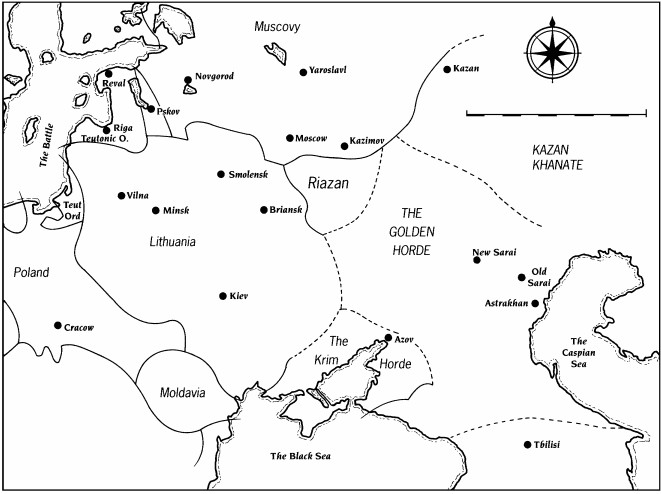 |
If you study the map
of the Mongol Empire, the Moscow region was the farthest
outpost. As long as the Russians collected tribute and
taxes for the Mongols, the Mongols
were content to ignore the lands that they owned and
leave them alone.
"Don't make us come up there and kill you!"
The fact that
the Khan accorded certain rulers in Moscow the status of tax
collectors worked in their favor. They quickly learned
that all they had to do to keep the Khan off their
backs was pay him the money and keep their people in
line. Since the Khan never visited the area
unless there was trouble, the Princes of Moscow were now
the de
facto rulers of Rus.
Another
benefit of paying their taxes was security. As long as
they paid their taxes, the Russians were left alone with no
serious enemies to worry about.
Over the course of the
next two and a half centuries, the Russians slowly but
surely gained
a great deal of military power.
|
|
Ivan the Great
Ivan
the Great had already been co-ruler of the Grand
Duchy of Moscow with his father Vasily for several
years when his father died. At age 22, Ivan
was educated and experienced when he took over in
1462.
During
his father's reign, the Grand Duchy of Moscow had by
this time become a compact and powerful state,
whilst her rivals had grown weaker. This state
of affairs very favorable to a statesman of Ivan III's peculiar
character. Ivan was an extraordinarily
cautious man who used cunning and patience to his
advantage.
Left
alone by the Khan, Ivan spent the next 20 years
gathering the Russian lands around him by war or
diplomacy. In this time, Ivan managed to triple the
territory of his state. In so doing, Ivan
became the supreme leader. He was named Grand Prince of Moscow and "Grand Prince of all Rus".
During
Ivan's rise to power, it did not escape his
attention that the Mongols themselves had grown weak
through a series of civil wars. At the time,
Ivan also knew Ahmed Khan was preoccupied with his
struggle against the Crimean Khanate.
Russia
had been paying tribute for nearly 250 years. Ivan
decided the time had finally come to take on the Great Khan.
Ivan
didn't bother attacking. He knew just what to
do - stop paying taxes!
In 1476 Ivan III
ceased paying annual tribute to the Horde. It
turned out that Ivan
was right. The Khan did not do anything
serious except to demand tribute and send a Mongol
representative to Moscow. And then he sent another.
And another.
|
 |
|
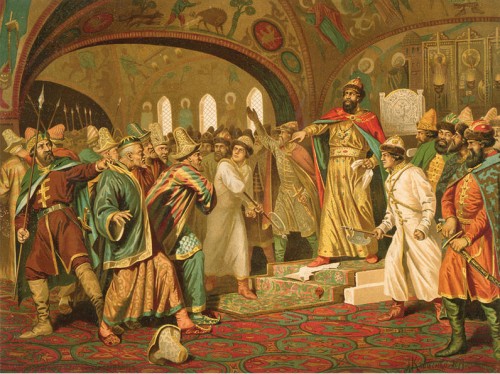 |
Ivan
just laughed. The picture on the left depicts
Ivan tearing up the Khan's letter.
For
the next four years, Ahmed Khan, the Mongol leader,
sent one bill collector after another to Moscow
carrying all sorts of dire threats, but these
threats accomplished nothing. The status quo
favored Ivan. He didn't want to fight.
He just wanted to be left alone. Stick and
stones might break his bones, but bills would never
hurt him.
Finally, after
four years of seeing his threats ignored, Ahmed Khan lost
patience and
decided to march on Ivan. In 1480 the Mongol
and Muscovite armies met on opposite sides of the Ugra River
which was about 100 miles due south of Moscow.
Right
from start, neither side made a move. Ivan, always a
cautious man, was reluctant to fight. Knowing
whoever was forced to cross the river first would be at a
disadvantage, Ivan had little incentive to
attack. In addition, he was waiting for reinforcements
he knew were on the way.
|
|
The Mongol leader, Ahmed Khan, was even more
cautious than Ivan III. The Khan had reason to be
cautious. He was astonished at the size of the Russian
force. Thanks to his years of neglect, the Khan had no idea
just how powerful the vassal state of Muscovy had grown.
Furthermore, Ivan had used the past four years to build up
and train his forces for the day when he would have to stand up
and fight. Ivan's army was impressive.
So for weeks they watched each
other, neither willing to cross the river and make the first
move. Meanwhile Ivan's forces kept getting bigger.
As always, Ivan had nothing to lose by waiting. And
Ahmed didn't want to expose his troops to murderous archers
while crossing that river. Stalemate.
Finally the
troops got restless and both sides went home. This curious
stand-off became known as the "Non-battle of the Ugra".
Ivan was able to end the Mongol domination over Russia
without even firing a shot. Never
again did the Russians pay tribute to a foreign power.
It was an amazing accomplishment.
At this
same time
the Golden Horde was starting to break up of its own accord.
After the assassination of Ahmed, it collapsed completely in
1502.
Meanwhile Ivan would
go on to be one of the longest-reigning Russian rulers in
history. Ivan the Great is still celebrated as one of the
greatest rulers in Russian history.
|
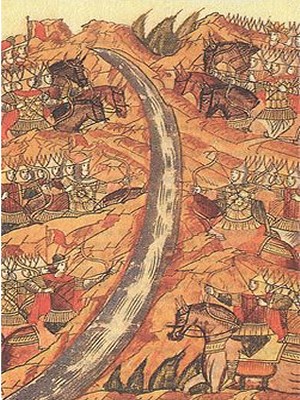 |
|
|
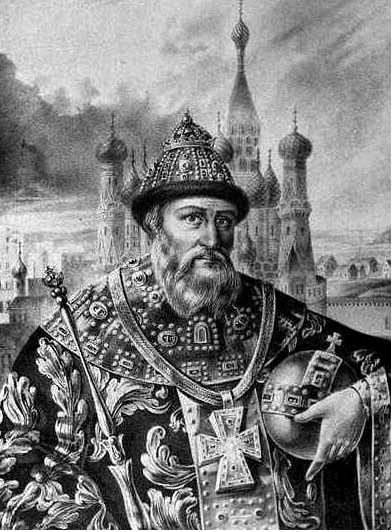 |
Ivan
the Terrible
Ivan
IV, better known as Ivan the Terrible, was
the grandson of Ivan the Great. He became the
First Tsar of Russia in 1547. Ivan IV was a
complex man who suffered from bouts of mental
illness. When he was mad, he was really mad.
For example, in 1581 Ivan beat his pregnant
daughter-in-law for wearing immodest clothing.
This caused a miscarriage. His son was furious
and engaged in a heated argument with his father.
Ivan the Terrible lost his temper and struck the
young man in the head with his pointed staff,
killing him. Bad move. Ivan's only other
son Feodor was mentally defective.
On the
other hand, when he was lucid, Ivan was an excellent
ruler. Ivan
set about expanding Russian territory. One of
his first moves was to attack the remaining Khans. Not
only were the Russians numerically superior to the
greatly weakened armies of the Khans, the
recent introduction of gunpowder weapons eliminated the old
superiority of the mounted archers of the Mongol
armies. Ivan quickly conquered all the territory to the foot
of the Urals.
Now
the question arose what to do with the land on the
other side. Ivan himself had nothing to do
with the conquest of Siberia. The credit would
go instead to the Cossacks. The annexation of
Siberia was one of the greatest triumphs in Cossack
history.
A merchant family, the Stroganovs, settled
agents in various territories, including Siberia, to
expand their fur and lumber trades. In the
mid-1550s, Tartar leader Kuchum Khan took over the
area in Siberia. He demanded tribute or he
would shut down the Stroganov operation. The
Stroganovs weren't going to give up that easily.
They wanted to protect their lands and their trade
business from the Tartars. So they hired the
Cossacks and their leader Yermak Timofeyevich as
mercenaries.
|
The Door Opens
In September
1581, Timofeyevich led 840 troops to wrest the Siberian city
of Sibir from Tartar control. With the use of firearms, the
Cossacks easily defeated Kuchum's forces.
With this single battle, Siberia came under complete control
of the Russian Empire.
That conquest opened the door. The last enemy between
Moscow and the Pacific Ocean had just been removed.
Only one problem - no one in Moscow knew the Pacific Ocean
even existed.
|
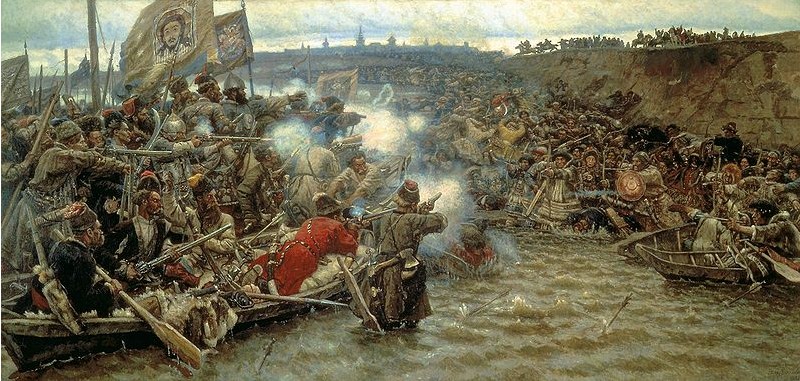 |
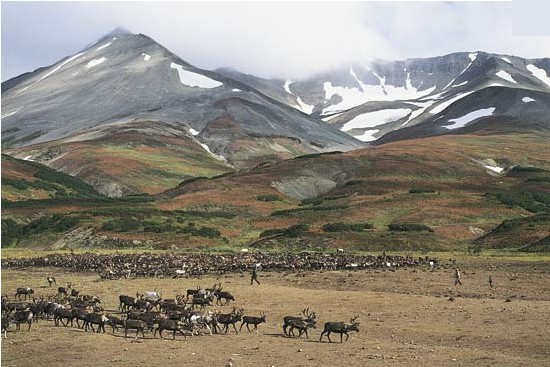 |
The next century would be one of exciting exploration
eastward. Following the path of the Great Steppe, the
explorers made one discovery after another.
Ironically, the Mongols had done the Russians an enormous favor.
By murdering and destroying countless villagers in their unstoppable
path of plunder, they had decimated the population of areas that had
few people to begin with.
Now the tribes the explorers met on
the way were much too primitive and too few in numbers to put up
much of a protest.
Even better, since the Russian explorers were not murderous savages bent on
conquest like the Mongols, the villagers felt no need to defend
themselves against the visitors.
Consequently the explorers rarely had to fight. Unlike the sad
Indian wars characteristic of the American expansion in the West, the Russians had the Mongols
to thank for doing the dirty work ahead of time.
|
Throughout the 17th century, each year saw a new wave of fur
traders and Cossacks cross the plains and the rivers. Any Jeremiah Johnson who wanted to get away
from it all now had this vast wilderness to lose himself into.
One year at a time, the explorers would establish outposts, settle
down for the winter, suffer through months of snow-bound isolation, and then renew progress in the spring.
In 1639 a Cossack named Moscovtin, hiking east from
Lake Baikal to Okhotsk, became the first Russian to
see the Pacific Ocean. It had taken 60
years since the Battle of Sibir in 1581 had opened
the door for the explorers to finally reach this stunning landmark.
The
fact that it took 60 years just to get from the
Urals to the Pacific without any opposition says it
all. The expanse of Siberia was endless.
In a
sense, the Russians had annexed an area so harsh, so
barren and
bitter that no one else wanted it. Like parts
of Alaska and Canada, much of this new territory was
practically uninhabitable. Nevertheless, there
were untold amounts of riches locked in those lands
waiting for the day when technology could tap those
resources. The gift of Siberia was a present
of unimaginable value to Russia.
Even
better, very little blood was spilled. Freed
of the necessity of fighting indigenous people
willing to defend their lands with their lives, ultimately the Russians were able to explore and settle this huge
landmass in far less time than the United States was able to settle
its own western frontier.
Outside of Russia, no one had any idea what
was going on. Jamestown, the first
English colony in America, had just been
founded. Galileo was exploring the
laws of gravity and suggesting the Earth
revolved around the sun. In Europe,
the Thirty Years War was decimating Germany
and propelling Sweden to its loftiest status
ever. The Ottoman Empire was expanding
rapidly.
Meanwhile, Russia was quietly becoming a
vast empire and no one in Europe had even
the slightest idea. It is important to
remember that 17th century Russia existed in
near-total isolation from the outside world.
Great events like the Renaissance,
the Reformation, the discovery of the
Americas and the birth of modern science had no effect on the
Russians whatsoever. Russia had technically been an empire
since Ivan IV conquered the Moslems on the Volga, but to westerners
the Russian Empire was still called Muscovy, a Medieval state more
Oriental than Occidental.
This would change in the next age.
Soon Peter the Great through
sheer willpower would drag Russia kicking and screaming into the
modern world.
|
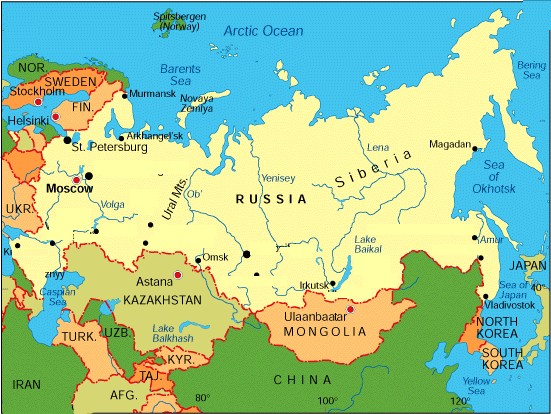 |
|
|